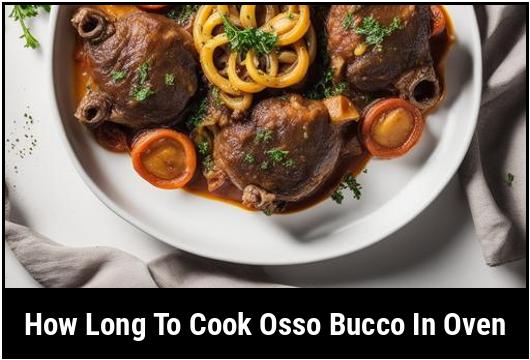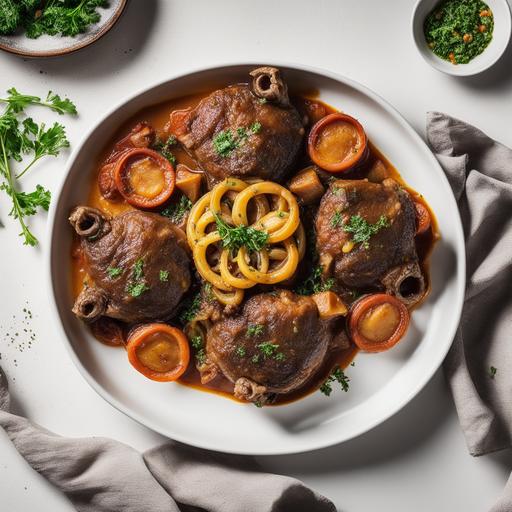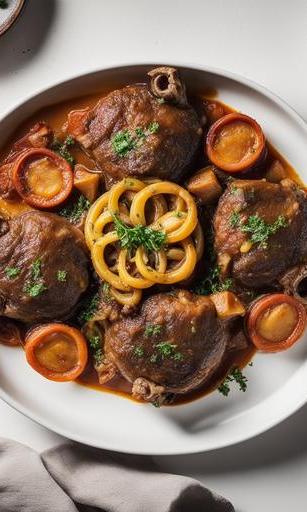[GUIDE] How Long To Cook Osso Bucco In Oven

Osso Bucco is a classic Italian dish known for its tender and flavorful braised meat. Traditionally made with veal shanks, osso bucco can also be prepared with beef or pork. Cooking osso bucco in the oven is a popular method that results in succulent, fall-off-the-bone meat. In this article, we will explore how long to cook osso bucco in the oven, along with key considerations, cooking techniques, troubleshooting tips, and variations to try. Whether you’re a seasoned chef or a beginner in the kitchen, this article will guide you through the process of preparing a delicious osso bucco.
Quick Answer: How Long To Cook Osso Bucco In Oven
The cooking time for osso bucco in the oven can vary depending on the size of the meat and the recipe you are following. In general, osso bucco should be cooked at a low temperature (around 325°F or 160°C) for 2 to 3 hours. This slow cooking process allows the connective tissues in the meat to break down, resulting in tender and flavorful meat.
However, it’s important to note that cooking times can vary based on the thickness of the meat and the desired level of tenderness. It’s always best to rely on visual cues and a meat thermometer to determine when the osso bucco is perfectly cooked.
Key Takeaways
- Cooking osso bucco in the oven requires slow and low heat for tender meat.
- The cooking time can vary between 2 to 3 hours, depending on the size and thickness of the meat.
- Using a meat thermometer is recommended to ensure the osso bucco reaches the desired level of doneness.
- Adding vegetables, broth, and aromatic herbs to the cooking liquid enhances the flavor of the osso bucco.
The Science Of Cooking Osso Bucco

To understand how to cook osso bucco perfectly, it’s helpful to understand the science behind the dish. Osso bucco is made from cuts of meat that contain a generous amount of connective tissue, such as collagen and elastin. These tissues are responsible for the tough texture of the meat. However, when cooked slowly at a low temperature, the connective tissues break down, resulting in tender meat.
The collagen in the connective tissue converts into gelatin during the cooking process. Gelatin has the ability to hold water, which contributes to the juiciness and moistness of the meat. The connective tissues also release flavorful compounds, adding depth and complexity to the dish.
Choosing Osso Bucco
When choosing osso bucco, it’s important to select cuts of meat that have a good amount of marbling and connective tissues. This will ensure that the osso bucco becomes tender and flavorful during the cooking process.
Traditionally, osso bucco is made with veal shanks, which are cut from the foreleg of the calf. Veal shanks are known for their delicate flavor and tender meat. However, if you prefer a heartier flavor, you can also use beef or pork shanks. The key is to choose cuts of meat that have the right amount of fat and connective tissue.
When purchasing osso bucco, look for cuts that are about 2 to 3 inches thick. Thicker cuts will take longer to cook and may require additional cooking time.
Preparing Osso Bucco
Before cooking osso bucco, it’s essential to prepare the meat properly. The following steps will ensure that the osso bucco turns out tender and delicious:
-
Trim the excess fat: Remove any excess fat from the osso bucco. While some fat is necessary to add flavor and moisture to the dish, too much fat can make the osso bucco greasy.
-
Season the meat: Season the osso bucco with salt and pepper, or your preferred seasonings. This will enhance the flavor of the meat. You can also add a sprinkle of flour to help with browning and thickening the sauce.
-
Sear the meat: Heat a large, oven-safe skillet or Dutch oven over medium-high heat. Add a small amount of oil or butter to the pan and brown the osso bucco on all sides. This step adds a rich caramelized flavor to the dish.
-
Remove the meat from the pan: Once the osso bucco is nicely browned, remove it from the pan and set it aside. This will allow you to sauté vegetables and deglaze the pan, adding even more flavor to the dish.
Ideal Cooking Temperature For Osso Bucco
To achieve tender and flavorful osso bucco, it’s important to cook it at a low temperature for an extended period. The ideal cooking temperature for osso bucco in the oven is around 325°F or 160°C. This gentle heat allows the connective tissues in the meat to break down gradually, resulting in tender meat.
Cooking osso bucco at a higher temperature will cause the meat to become tough and chewy. It’s crucial to resist the temptation to crank up the heat in order to speed up the cooking process. Slow and low is the key to achieving the best results.
Osso Bucco Cooking Time

The cooking time for osso bucco in the oven can vary depending on the size and thickness of the meat. In general, osso bucco should be cooked for 2 to 3 hours at a low temperature of 325°F or 160°C. However, it’s essential to monitor the meat closely to determine when it is perfectly cooked.
Using a meat thermometer is the most reliable method of determining the doneness of osso bucco. The internal temperature of the meat should reach around 195°F or 90°C. This ensures that the connective tissues have fully broken down, resulting in tender meat.
Keep in mind that thicker cuts of osso bucco will require a longer cooking time, while thinner cuts may cook more quickly. Adjust the cooking time accordingly, and always rely on visual cues and a meat thermometer for accuracy.
| Thickness of Osso Bucco | Cooking Time |
|---|---|
| 1 inch | 1.5 to 2 hours |
| 2 to 3 inches | 2 to 3 hours |
| 3 to 4 inches | 3 to 4 hours |
It’s important to note that these times are just guidelines. The ultimate goal is to achieve tender, fall-off-the-bone meat, so adjusting the cooking time based on the tenderness of the meat is essential.
Cooking Techniques
There are a few different cooking techniques you can use when preparing osso bucco in the oven. Here are two popular methods:
1. Braising: Braising is the most common method for cooking osso bucco. After browning the meat, place it back into the pan along with vegetables, broth, and aromatic herbs. Cover the pan with a lid or foil and transfer it to the oven. The liquid and low heat create a moist environment, allowing the meat to cook slowly and become tender.
2. Slow-roasting: Slow-roasting osso bucco involves cooking the meat uncovered at a low temperature for an extended period. This method allows the exterior of the osso bucco to develop a rich, caramelized crust while the interior becomes tender. Slow-roasting is a great option if you prefer a more concentrated flavor and texture.
Both cooking techniques can be effective in achieving tender and flavorful osso bucco. The choice is a matter of personal preference and the desired outcome.
Monitoring And Troubleshooting
While cooking osso bucco in the oven may seem straightforward, it’s important to monitor the meat closely to ensure optimal results. Here are a few tips and troubleshooting techniques to consider:
1. Check for dryness: While slow cooking in the oven helps retain moisture, it’s still possible for the osso bucco to become dry if overcooked. To prevent this, baste the meat occasionally with the cooking liquid. If the cooking liquid evaporates too quickly, add more broth or water to the pan.
2. Adjust the cooking time: As mentioned earlier, cooking times can vary based on factors such as the thickness of the meat and the oven’s accuracy. If you find that your osso bucco isn’t becoming tender within the recommended cooking time, prolong the cooking time and monitor the meat closely for desired doneness.
3. Use a meat thermometer: A meat thermometer is a useful tool for accurately determining the internal temperature of the osso bucco. Insert the thermometer into the thickest part of the meat, away from the bone. When the internal temperature reaches around 195°F or 90°C, the osso bucco is likely done.
4. Adjust oven temperature: If you find that the osso bucco is not cooking evenly or browning too quickly, you may need to adjust the oven temperature. You can lower it by 25°F or 10°C to allow for more gentle heat. Additionally, rotating the pan halfway through the cooking process can help ensure even cooking.
By paying close attention to these monitoring and troubleshooting techniques, you can avoid potential issues and achieve the perfect osso bucco.
Osso Bucco Cooking Instructions
Now that we have covered the key considerations and techniques, let’s dive into a step-by-step guide on how to cook osso bucco in the oven:
-
Preheat the oven: Preheat your oven to 325°F or 160°C.
-
Prepare the osso bucco: Trim the excess fat from the osso bucco and season it with salt and pepper. Optionally, you can sprinkle a small amount of flour to help with browning and thickening the sauce.
-
Brown the osso bucco: Heat a large, oven-safe skillet or Dutch oven over medium-high heat. Add a small amount of oil or butter to the pan and brown the osso bucco on all sides. This should take about 2 minutes per side. Once browned, remove the meat from the pan and set it aside.
-
Sauté vegetables: In the same pan, add chopped onions, carrots, celery, and garlic. Sauté the vegetables until they begin to soften and develop some color. This will take about 5 minutes.
-
Deglaze the pan: Pour a splash of white wine, red wine, or broth into the pan to deglaze it. Use a wooden spoon to scrape up any browned bits from the bottom of the pan. This step adds depth and flavor to the dish.
-
Add the osso bucco back to the pan: Place the osso bucco back into the pan, nestling it among the sautéed vegetables. Add enough broth or stock to partially submerge the meat. The liquid should reach about halfway up the sides of the osso bucco.
-
Add herbs and spices: Tuck in a few sprigs of fresh thyme, rosemary, or bay leaves. These aromatic herbs will infuse the osso bucco with flavor. You can also add a pinch of dried herbs such as oregano or basil.
-
Cover and transfer to the oven: Cover the pan with a lid or foil and transfer it to the preheated oven. Allow the osso bucco to cook undisturbed for 2 to 3 hours, or until tender. Baste the meat occasionally with the cooking liquid to keep it moist, and add more liquid if necessary.
-
Check for doneness: Around the 2-hour mark, begin checking the osso bucco for doneness. Insert a meat thermometer into the thickest part of the meat, away from the bone. When the internal temperature reaches around 195°F or 90°C, the osso bucco is likely done. Alternatively, you can use a fork to test if the meat easily pulls away from the bone.
-
Rest and serve: Once the osso bucco is cooked to your desired tenderness, remove it from the oven and let it rest for a few minutes. This will allow the juices to redistribute throughout the meat. Serve the osso bucco with the cooking liquid and vegetables, and garnish with freshly chopped parsley if desired.
Variations

While the traditional osso bucco recipe calls for veal shanks, you can experiment with different meats and flavor profiles to create unique variations of the dish. Here are a few ideas:
1. Beef Osso Bucco: Substitute veal shanks with beef shanks for a heartier flavor. The longer cooking time of beef shanks may be necessary to achieve the desired tenderness.
2. Pork Osso Bucco: For a different twist, use pork shanks instead of veal. Pork shanks offer a rich, savory flavor that pairs well with a variety of herbs and spices.
3. Gremolata: Top your osso bucco with gremolata, a traditional Italian garnish made with lemon zest, garlic, and parsley. The bright and zesty flavors of gremolata add a refreshing element to the rich dish.
4. Mushroom Variation: Add sliced mushrooms to the pan while sautéing the vegetables. The earthy flavor of mushrooms pairs beautifully with osso bucco and creates a rich, umami-packed sauce.
Feel free to experiment with different ingredients and flavors to create your own signature osso bucco dish.
When Things Go Wrong
Sometimes, even with careful attention, things may not go as planned when cooking osso bucco in the oven. Here are a few common issues and solutions:
1. Tough Meat: If your osso bucco turns out tough, it may need more cooking time. Return the meat to the oven and continue cooking until it reaches the desired tenderness.
2. Lack of Flavor: If your osso bucco lacks flavor, it may be due to inadequate seasoning or insufficient cooking time. Adjust the seasonings and allow the dish to cook for longer to develop more depth of flavor.
3. Excess Fat: If your osso bucco has too much fat, you can skim off the excess fat from the cooking liquid before serving. Alternatively, you can refrigerate the dish overnight and remove the solidified fat from the top.
4. Dry Meat: If your osso bucco ends up dry, it may have cooked for too long or at too high a temperature. To remedy this, you can serve the dish with extra sauce or broth on the side, or use the drippings to make a gravy.
Remember, cooking is a learning process, and even experienced chefs encounter challenges in the kitchen. Don’t be discouraged if your osso bucco doesn’t turn out perfectly the first time. With practice and a little troubleshooting, you’ll be able to achieve fantastic results.
Serving Osso Bucco
Osso bucco is often served with creamy mashed potatoes, polenta, or risotto to soak up the flavorful sauce. The tender meat pairs beautifully with these comforting sides.
To elevate the dish further, garnish the osso bucco with freshly chopped parsley or gremolata for a burst of freshness. Serve with a side of steamed vegetables or a crisp salad to balance the richness of the meat.
Ladle the cooking liquid over the osso bucco and vegetables to bring additional moisture and flavor to the plate.
Best Practices For Osso Bucco Cooking
To ensure the best results when cooking osso bucco in the oven, consider the following best practices:
1. Use quality ingredients: Choose fresh, high-quality meat and vegetables for the best flavor. Opt for organic, grass-fed, or locally sourced meat whenever possible.
2. Patience is key: Osso bucco requires slow, low cooking to achieve the desired tenderness. Avoid the temptation to speed up the process by increasing the cooking temperature.
3. Season appropriately: Season the osso bucco with salt and pepper, or your preferred seasonings, to enhance the flavor of the meat. Don’t be afraid to experiment with different herbs and spices to create your own unique flavor profile.
4. Monitor closely: Keep a close eye on the cooking process, checking for doneness, basting the meat, and adjusting the oven temperature as needed.
5. Rest and Serve: Allow the osso bucco to rest for a few minutes after cooking to let the juices redistribute. Serve with the cooking liquid and vegetables for maximum flavor.
Conclusion
Cooking osso bucco in the oven is a delicious and rewarding culinary experience. By following the guidelines outlined in this article, you can achieve tender, flavorful meat that will impress your family and guests. Remember to choose the right osso bucco cuts, prepare them properly, cook at a low temperature, and monitor the meat closely to achieve the desired doneness. With practice, you’ll become a master at cooking osso bucco in the oven and enjoy the hearty, comforting flavors of this classic Italian dish.
FAQS
What Temperature Should I Set My Oven To When Cooking Osso Bucco?
It’s recommended to set your oven to 350 degrees Fahrenheit when cooking osso bucco.
How Long Should I Cook Osso Bucco In The Oven For Tender Meat?
Typically, osso bucco should be cooked in the oven for 2 to 3 hours until the meat is fork-tender.
Do I Need To Cover Osso Bucco When Cooking It In The Oven?
Yes, it’s best to cover the osso bucco with a tight-fitting lid or aluminum foil to prevent the meat from drying out.
Should I Sear Osso Bucco Before Cooking It In The Oven?
Yes, it’s recommended to sear the osso bucco in a hot skillet for a few minutes on each side before transferring it to the oven. This will help to develop a flavorful crust on the meat.
Can I Cook Osso Bucco In A Slow Cooker Or On The Stovetop Instead Of The Oven?
Yes, osso bucco can be cooked in a slow cooker or on the stovetop for 6 to 8 hours on low heat until the meat is tender. However, cooking it in the oven will result in a richer, deeper flavor.
Sources
About the Author Jenny
I'm Jenny, a housewife with an unwavering passion for food. My culinary journey began with my grandmother's kitchen, and it's now a full-fledged food blog. I've turned my love for cooking into a creative outlet, sharing recipes and stories with a global community of fellow food enthusiasts. It's proof that being a housewife can also mean pursuing your passions and savoring life's delectable moments.
